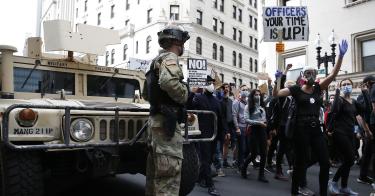On June 6, 1944, among those to take the first harrowing steps on the wet sands of Normandy were National Guardsmen from Maryland’s 29th Infantry Division. They bled just as much as their comrades in arms. They fought just as hard to get off the beaches. And when those who survived crested the scrubby bluffs above the German defenses, they changed the course of World War II.
Today we remember D-Day—exactly 76 years ago—as a signature achievement of the Greatest Generation. Still, D-Day was just one day. In addition to serving abroad, armed forces members from the citizen-militias of the colonial era to our modern-day warriors have safeguarded American communities faithfully and selflessly for two-and-a-half centuries. They saved San Francisco after the Great Earthquake and fire of 1906. They helped rescue New Orleans after Hurricane Katrina.
Most recently, both National Guard and active-duty forces helped bend the curve during the COVID-19 outbreak. People marveled, for instance, at how quickly and efficiently they were able to convert New York City’s Javits Center into a hospital and staff it with armed services medical personnel.
Yet some would have you believe these servicemen and women have gone from heroic good guys to bad guys in less than a month.
A chorus of critics—including some mayors, governors, activists, and journalists—are bemoaning the “militarization” of America. By this they mean employing troops to help restore peace in cities wracked by uncontrolled violence following the death of George Floyd, a handcuffed black man who died after a white Minneapolis police officer knelt on his neck for nearly nine minutes.
The National Guard tweeted Saturday: “Today, more than 43,300 National Guard members in 34 states and D.C. are assisting law enforcement authorities with ongoing civil unrest, while more than 37,000 Guard Soldiers and Airmen continue to support the COVID-19 response.”
Complaints that the use of the National Guard creates a troubling “militarization” could not be more disingenuous.
Let’s start by considering what military troops actually do when used in the U.S. Typically, the primary role they are assigned is guarding property. This mission doesn’t interfere with lawful protest in any manner.
The presence of the National Guard is only a problem for people bent on destruction—those who want to break things, burn things and hurt people.
In fact, people exercising their First Amendment rights—even those undertaking peaceful civil disobedience—are served as well. The military is there to protect them, too – and stop the violence and looting so they can peaceably demonstrate.
The second mission the military usually performs in our country is supporting law enforcement. This is anything but “militarizing” the response. Rather, the military is freeing up, enabling and supporting police, fire, and EMT personnel so they can do their jobs. That makes our streets safer, not less free.
In several of our cities, it is very clear that these additional resources are needed. Peaceful protesters fighting for a righteous cause are not the only people who have taken to the streets. Many others are trying to exploit the current protests over the death of George Floyd, using them as an opportunity to turn to rioting and looting—acts of violence that can’t be tolerated. Also in the mix are professional agitators –homegrown as well as foreign—from across the political spectrum.
Dealing with all this is daunting. Not bringing in the assets needed to safeguard the rights, freedom and property of all citizens is just wrong.
It is also worth reflecting on what the mission is and for whom the military work. When our soldiers are sent onto our streets, they are there to protect our freedoms, lives and property—not to take them away.
Our troops serve under lawfully elected civilian authorities. They support those authorities; they don’t supplant them. And how those authorities may use those troops is governed by a plethora of laws, all of which have passed constitutional muster. To claim that having the military help quell violence is unconstitutional is utter nonsense.
Because the National Guard and active-duty forces serve under civilian authority, their effectiveness is often determined not by their training and capabilities (which are usually more than adequate), but by the competence of the civilian leaders who direct them.
Cities can use the military to help deal with rioting and looting without dishonoring the cause of peaceful protestors. Washington is a case in point.
Yes, there was much squabbling between the mayor and federal authorities over use of the National Guard. But after the squabbling ended and the Guard deployed, looting stopped. People continue to conduct lawful protests unabated.
These are facts conveniently ignored by people who decry “militarization” and insult service members who are willing to put their lives at risk to keep peace on our streets.
As we remember those American heroes who stormed the beaches of Normandy 76 years ago, we should also remember those soldiers here at home who stand guard on our street corners, protecting our individual rights as the nation works its way through an extraordinarily difficult season of division and disease.
This piece originally appeared in Fox News




